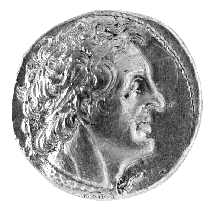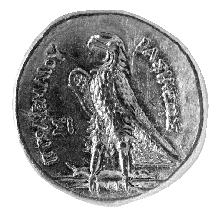



(55) Egypt, Ptolemy II - AV pentadrachm, c. 285-246 B.C., 17.81
g. (inv. 91.097).
Obverse: Diademed head of Ptolemy I r., wearing aegis.
Reverse: Eagle on thunderbolt l.; in l. field, ![]() ;
; ![]()
![]() :
of King Ptolemy.
:
of King Ptolemy.
Provenance: Bank Leu, 1973.
Bibliography: J. Svoronos, Ta Nomismata tou Kratous ton Polemaion
2 (Athens 1904) 712, pl. 21.1.
Ptolemy II Philadelphos (308-246 B.C.), the son of Ptolemy I and Berenike
I, was made co-ruler with his father in 285 B.C. and became sole ruler at
his father's death in 283 or 282 B.C. Although known for his wealth and
extravagant living, he was also a patron of scholars who brought many Greek
intellectuals to the famous Library and Museum of Alexandria, which in this
period became the cultural and intellectual center of the Greek world. He
established many Greek settlements in Egypt.
Ptolemy II established his family's ruler cult by marrying his sister, Arsinoe
II, and deifying himself and members of his family. He established dynastic
continuity on his coins by retaining the types of Ptolemy I, so that it
is often difficult to date the coins to one reign or the other. But while
under Ptolemy I coins had been issued only in Egpyt, Ptolemy II established
mints in Phoenicia, which identified their coins with mint-marks. The mark
![]() identifies the source of this coin as Sidon. The portrait of Ptolemy
I appears to be losing some of its individualized character. It still has
the prominent chin and bulging forehead of the coins of Ptolemy I, but the
nose is less hooked and the age of the king harder to determine (see no.
54). The pentadrachm was the most common gold denomination under the Ptolemies.
identifies the source of this coin as Sidon. The portrait of Ptolemy
I appears to be losing some of its individualized character. It still has
the prominent chin and bulging forehead of the coins of Ptolemy I, but the
nose is less hooked and the age of the king harder to determine (see no.
54). The pentadrachm was the most common gold denomination under the Ptolemies.
K.J.B.



All contents copyright (c) 1996.
Lawrence University
All rights reserved.